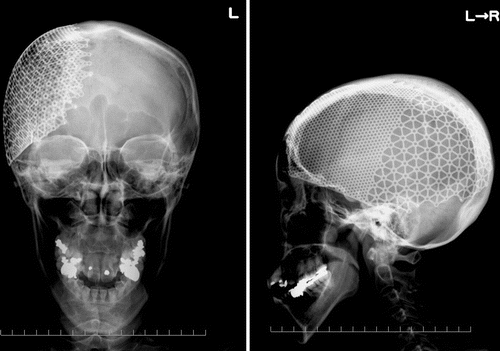A Case of a Depressed Patient With Major Titanium Cranial Base Reconstruction Successfully Treated by ECT
To the Editor: There is virtually no information regarding the safety of ECT in patients with titanium cranial base reconstructions. A 41-year-old Japanese woman was admitted to our hospital due to depression and refusal of chemotherapy for her stage IV diffuse large B-cell lymphoma (DLBCL). She had a past medical history of meningioma and received surgical intervention with major titanium cranial base reconstruction. The titanium mesh cranial base (190×120×70 mm, 0.8 mm in thickness) covered almost all of her right hemisphere (Figure 1). Since her DLBCL was diagnosed, she has received multiple chemotherapies. Several months before her admission, she developed major depressive disorder and refused any kind of therapeutic intervention for her DLBCL. At that time, she scored 20 points on the 17-item Hamilton Depression Rating Scale (HAM-D). We hypothesized that her decision-making capacity was impaired due to depression, and she refused additional chemotherapies. She was treated with the maximum dosage of sertraline over 1 month; however, there was no significant improvement in her depression. It was absolutely essential that her chemotherapy be reinstituted, or her DLBCL was highly likely to flare up. Therefore, ECT was recommended.

FIGURE 1. X-Ray Images of the Large Titanium Mesh Cranial Base
Currently, there are no guidelines regarding ECT in patients with a titanium device, and it is unknown what happens to such patients during electric stimulation. A titanium device in the skull could heat up and cause damage to the brain. Although there are some anecdotal reports of ECT with no complications in patients with a small titanium device (1, 2), there was no guarantee for safe ECT practice. Making our decision more difficult, the titanium plate in our case was quite large. At the same time, we recognized the fact that her DLBCL would have a very poor prognosis if it were to flare up again. After intensive discussions, we concluded that the potential risk of ECT was outweighed by the harm of leaving this end-stage DLBCL patient without chemotherapy. Comprehensive information about the benefits and risks of ECT in her case were offered to the patient and her family members, and written consent was obtained from them. Six courses of ECT (current, 900 mA; pulse width, 0.5 ms; frequency, 70 Hz; and duration, 4 seconds) were given to the patient using left unilateral stimulation technique to avoid direct electrical stimulation to the titanium device. Fortunately, there were no adverse effects throughout her treatment sessions. After the ECT, her HAM-D score declined to 2, and the patient decided to restart chemotherapy.
There are two important implications of this case report. First, ECT was safe in a patient with a large titanium cranial base when conducted unilaterally. Second, ECT could correct an inappropriate decision based on impaired decision-making capacity because of depression, as shown in this case.
1 : Safety of electroconvulsive therapy in the presence of cranial metallic objects. J ECT 2014; 30:62–68Crossref, Medline, Google Scholar
2 : Is electroconvulsive therapy safe in the presence of an intracranial metallic object? Case report and review of the literature. J ECT 2013; 29:231–238Crossref, Medline, Google Scholar



